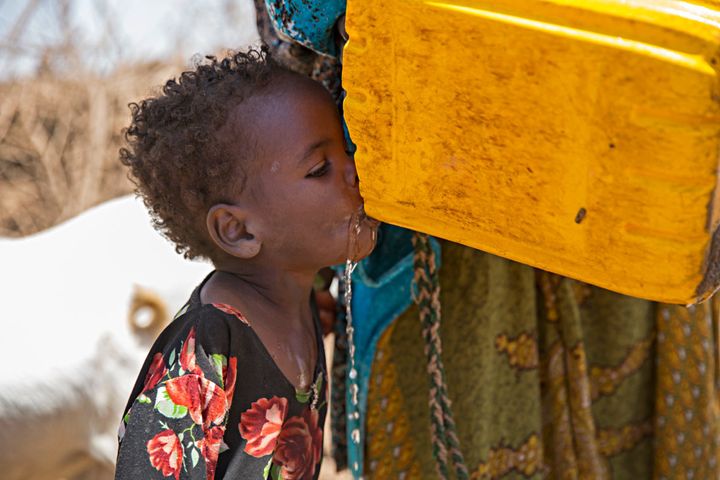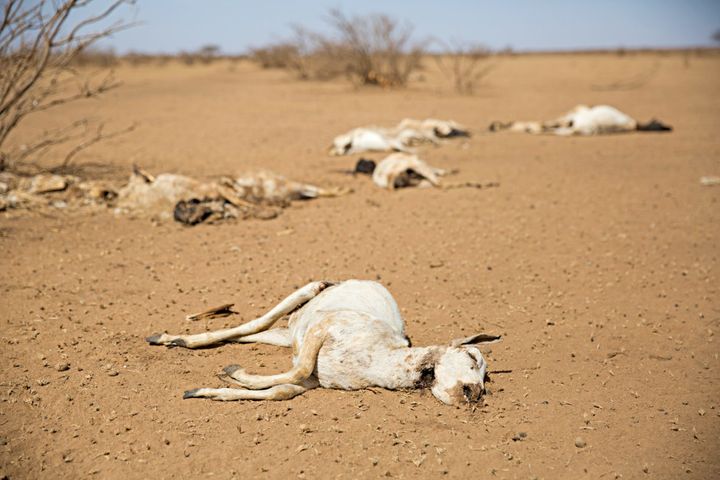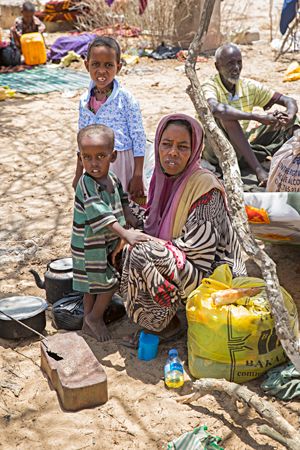6.7 million people in Somalia face hunger according to recent reports from the UN’s Food and Agriculture Organization (FAO). Though the much-anticipated Gu — or “long” — rains finally arrived, the situation hasn’t improved. In fact, hunger levels are projected to rise.
Living on a “knife-edge”
Somalia has four seasons: two rainy (Gu and Deyr) and two dry (Jilaal and Hagaa). This year’s Jilaal, which lasts from December to March, was hotter and drier than normal, putting increasing pressure on dwindling water resources. A post-Jilaal evaluation showed elevated risk of extreme hunger.

A young girl in Somaliland — a semi-autonomous region in Somalia — drinks water trucked in by Concern Worldwide. Photo: Kieran McConville
The monsoon-like Gu rains — which generally start in April and finish in June — nourish crops and rejuvenate lands deteriorated from grazing. But this year they arrived late and ended early, delivering half as much rainfall as usual.
Due to the poor rains, harvests in both August and November are predicted to be much less fruitful than normal. By September, it is feared that most families will have exhausted all their food supplies.
“The current situation clearly presents all the hallmarks of the 2010/ 2011 descent into famine.” — Subodh Vijapure, Concern Emergency Program Manager
“With the minimal rain and crop failure in Lower Shebelle and Gedo region — which is the food basket of South Central Somalia — the food crisis will last for a longer time,” explains Concern’s Emergency Program Manager, Subodh Vijapure.
As crops fail and food prices soar, it’s projected that this year some 1.4 million children will be acutely malnourished — a 50% increase since last year. FAO surveys show that of the nearly seven million people that facing hunger, 3.2 million are living on the “knife-edge” of starvation. The threat of famine continues to persist.
“The humanitarian situation in Somalia is deteriorating rapidly due to drought and an increase in conflict,” says Vijapure. “The current situation clearly presents all the hallmarks of the 2010/ 2011 descent into famine.”

The carcasses of hundreds of dead sheep and goats litter the landscape in Somaliland. Pasture and water supplies are disappearing across the Horn of Africa. Photo: Kieran McConville
Livestock, thirsty and hungry, have been dying in droves, their carcasses littering the barren landscape. Families have left their homes and trekked for days — even weeks — desperately seeking water. Since last year, 766,000 people have been internally displaced due to drought. The journey is often filled with unimaginable hardship. Many, particularly children, die along the way.
With drought comes disease
Hunger isn’t the only thing that has spread across the country. As remaining sources of ground and surface water have slowly evaporated, the proportion of harmful bacteria in the water has increased. People know the dirty water can make them sick, but in desperation, many drink it anyway.
According to a recent poll, only 15% of Americans are even aware of the [East Africa hunger] crisis.

A displaced family rests under the shade of a tree just outside of Mogadishu, Somalia. Photo: Kieran McConville
According to the World Health Organization, Somalia is suffering outbreaks of cholera, diarrhea, and other diseases. By June, there were more than 71,000 cases of acute diarrhea and cholera in the country. Somalia is also experiencing the worst measles outbreak in four years, with some 14,000 suspected cases of the disease. Under normal circumstances, deaths from these illnesses can be prevented. Right now, many are too weak from dehydration and hunger to reach medical centers or fight off infections.
Somalia’s greatest needs are life-saving measures, says Vijapure. “The highest priorities are access to food, safe water, and treatment for malnourished children at a high risk of death.”
An unseen crisis
Tragically, Somalia is not the only country facing widespread hunger this year. Twenty million people across East Africa are at risk of starvation due to severe drought, or, in the case of South Sudan, ongoing conflict. Kenya and Ethiopia are experiencing serious food shortages, and in South Sudan almost two million people remain on the brink of famine. The UN has called the East Africa hunger crisis one of the largest humanitarian emergencies since World War II, but according to a recent poll only 15% of Americans are even aware of the crisis.
What Concern is doing to help
Concern is operating in all four countries impacted by the East Africa hunger crisis and we have massively scaled up our operations to respond to the increasing numbers of people in urgent need.

Beneficiaries in Somalia collect their non-food item kit, donated by Irish Aid, and being distributed by Concern Worldwide. Photo: Mohamed Abdiwahab
Beneficiaries in Somalia collect their non-food item kit, donated by Irish Aid, and being distributed by Concern Worldwide. Photo: Mohamed Abdiwahab
Our response in Somalia includes:
- Trucking clean water to families that are suffering from severe drought
- Providing cash transfers so that people can buy the food and other items that they need most
- Emergency nutrition support to help treat the growing numbers of children and pregnant and breastfeeding mothers suffering from acute malnutrition
- Building latrines and teaching safe hygiene practices to help curb the spread of cholera
- Distributing shelter and household items to the many families who are living in crowded informal displacement camps
- Constructing emergency education centers so displaced children can continue their studies
